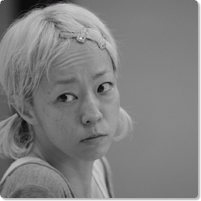Dictee and The Rite of Spring
- Theresa Hak Kyung Cha’s highly experimental and difficult to interpret book Dictee (meaning dictation) is written in Korean, French, English and Chinese characters with quotations from a variety of cultural backgrounds and deals with the forces that tear apart concepts of gender and multicultural existence. The stage performance you created based on that book was composed as a series of fragments including some of your own personal experiences along with recitation of text, physical expressions of agony, and acts like making drawings and writing Chinese characters on the set and talking directly to the audience, which as a whole succeeded in creating an overall sense of empathy with the world of questioning and discomfort expressed in Theresa Cha’s book Dictee . The music you used was also a mix of unexpected and seemingly disharmonious things like Japanese songs and traditional Korean Samul nori .
- It is a book that I was given by a dancer friend in 2006. It is not poetry and not a novel but a strange sort of text that I found to be very dance-y. There are section that you think are the author’s own words but turn out to be quotes from another person. What’s more it is written in multiple languages, so you never know what to believe. I realized that the world this book creates is not one that I could bring to the stage in my native language, my mother tongue, so I wanted to use language that was not my mother tongue. Then I asked myself what my native language is on the stage. I decided that more than the Japanese language, it was dance itself. Next I decided to consider what could be dance that is not my native language could be. That led me to the decision to try doing dance that always possessed an aspect that is “difficult to dance.” For the music I chose things that I couldn’t feel good about dancing to, music that I felt some resistance to, the kind of music that is engrained with people’s memories. So, I used [Bach’s] St. Matthew Passion and the Japanese folk song Furusato (My Hometown).
- Also, in the work that you presented in 2012 with your company, titled Kisetsu no nai Machi (Town without Seasons; taking motifs from Shugoro Yamamoto’s novel) you used Beethoven’s Ninth Symphony, didn’t you? Is it a deliberate attempt to take on and deal with something—in this case famous music—that in some sense could be considered overly orthodox.
- Yes. When you use familiar music that the brings memories or associations to the minds of the audience, it forces them to compare their image of that music with the dance that they see unfolding in front of them, doesn’t it? It becomes a sensation like watching a Kabuki performance while listening to the storyline commentary on the headset, as if you are reading an accompanying text as you watch the performance. It is like receiving guiding words that bring up memories within people while they are watching [perhaps unrelated] events unfold before them in real time, and then sometimes discomforting but sometimes pleasant feelings that brings (laughs). I am deliberately orchestrating those two elements, at times synchronizing it and at times juxtaposing it.
- In light of that, the approach you took with your latest work, The Rite of Spring , it appears that, in contrast, you are dealing directly with Stravinsky’s ballet music in your choreography. The carefully composed dance is performed with raging intensity, as if you are pushing the limits of physical strength and endurance.
-
I did a considerable amount of research on the score of Stravinsky’s
The Rite of Spring
, analyzing in detail each of the compositional motifs and the tones used in them to choreograph the movements and scenes. It happened to be the 100th anniversary of the premiere of the work and the dancers were anxious to try a performance, so I decided to go ahead with it. But, some suggested quietly that it didn’t have to be quite that intense and physically demanding (laughs). I went ahead and made it very physically intense and aggressive choreography, and at the same time I was able to overcome to some degree what I had feared to be lacking in the dancers. One example was with our dancers who had no experience performing in large spaces and grasped spaces on too small a scale. If you don’t have experience dancing in large spaces, you don’t know how important each movement, such as the extension of the fingers, can be. I believe that with this work I really got a chance to work with them thoroughly on this aspect.I also felt a lack of understanding of orchestra music. So, this time I began from the start by teaching the dancers how to read the musical score and made sure they knew what movements they would be bringing to what sound of what instrument. I knew that if they can’t hear music with enough sensitivity they won’t be able to fully share in my choreography. This is an area that I often feel a lacking in when I work with Japanese dancers.
- I hear that you also do your own editing of the music you use in your pieces.
- Yes, I do. In Japanese dances pieces music is most often used as background music or as a stimulating accompaniment. Or it may be use as an ostentatious display of explosive sound. But, music is really something much richer with great depth, and in composition it can have an aspect of highly mathematical sophistication. I get such a clear perception of the structure of music’s mathematical spaces that I can virtually see them, but I feel that in most cases choreographers and dancers only use music in a flat, 2-dimensional way. Also, no matter how fully one might use the inherent power in the music, that power can be instantly diluted when you apply lighting to it in the wrong way, so maintaining the right balance of the music and the lighting is absolutely essential. Although it might sound strange to say, “seeing with the ears,” I believe that visual elements must be judged through aural perception.
To stop moving would be to die
- Now I would like to ask about yourself. We are told that you have suffered from connective tissue rheumatic disease since childhood.
-
Yes. Even now I have to work to use the support of the muscles to keep all of the joints in my body from hurting. In the morning I can only move slowly, like a Noh actor’s movements, and it takes all morning, doing yoga and such, to gradually loosen up my body so I can finally move freely in the afternoon. When I was a child I did [apparatus] gymnastics and swimming, with practice before and after school every day. In swimming, I got to the point where I was chosen for the national training program for the Junior Olympics, and in gymnastics I liked doing things like back flips. But, when I was in 5th grade in elementary school I was in a traffic accident and couldn’t do any sports for three months. After that I couldn’t do the things I had been able to do before the accident, in both gymnastics and swimming, so I went through a difficult time emotionally and turned a bit bad (laughs). Then, in my first year of middle school I was having pain in my joints, and when I was taken to a doctor who specialized in the field, I was diagnosed with rheumatism. I was also told that my immune system was weak and that I should stop doing sports like swimming or gymnastics because I would gradually loose the cartilage in all my joints. The doctor went on to say that if I don’t move at all the cartilage of my joints would stiffen up, so he suggested that I try dance as an alternative. That is how I started dance.
- Once you started, did you like dance from the beginning?
- It was so unlike the sports I was used to and I couldn’t understand the value system that wasn’t based on winning or losing, so it wasn’t interesting for me at all. In ballet they always had us doing these boring exercises, and there were kids a lot younger than me who could already dance with great skill. So, even though I liked to joke around and play the bad kid at school, in ballet class I had to be quiet and well behaved. Also, because of the pain in my joints, the stretching exercises were quite difficult for me. But, I didn’t want to complain about the pain because people would think I was just slacking off.
- But you didn’t just quit and walk away from it. So, it is hard to tell whether you were a jokester or really a serious student (laughs).
- In fact, I had this fear that if I didn’t keep exercising I would lose the use of my joints. The joints in my finger hurt too, so I practiced a lot on the piano, too. I just had the feeling that if I stopped moving I would die. Still, I had all this undirected energy in me, and I guess that is why I joked around played the bad kid, which I didn’t really enjoy anyway. So, in that sense it was better for me just to go to those boring ballet lessons, rather than doing nothing. I thought of it as a form of rehabilitation, and that is why I kept doing it as a hobby through college and even after I graduated and got a job in a stock brokerage.
In that job, I had a good sales record but it was just too stressful, so I quit in 1993. The only thing I had been doing other than my job at the time was dance, so the day after I quit my job and collected my retirement fee, I set off for New York quite impulsively. It was Christmas of 1993. In New York I went to open classes at studios and to the Merce Cunningham Studio. I was trying to use the money I had only for dance, so I wasn’t eating and drinking well and, finally, one day I collapsed in my apartment. A friend who happened to come by found me and took me to the hospital. At the hospital waiting room there were so many homeless faking illness to get out of the cold that my turn to see a doctor never came around for quite a while (laughs). When they finally did examine me the diagnosis was a stomach ulcer and malnutrition.- With malnutrition you were no better off than the homeless, were you? (Laughs)
- You’re right, I wasn’t. (Laughs)
Dance for me can only be found on the path I walk myself
- That time in the 1990s was one when the center of dance was shifting from America to Europe, wasn’t it?
-
Yes, it was. I feel there wasn’t much of real interest [in America]. Anyway, at the end of the three-month period that I could stay there without a visa, I returned to Japan. After that I did things like starting a class for children with learning disabilities and helping out at Yokohama ST Spot, where they were just beginning to experiment with organizing dance events. I very much wanted to try creating a dance piece there, so in March of 1996 I created a 60-minute work for five dancers titled
neighbors
and put it on as a 3-performance self-promoted event. Looking back on it now, it was a rather imprudent thing to do. (Laughs) I never had much interest in my own body as a dancer, so from the beginning I wanted to do choreography [more than performing]. The first 30 minutes of the piece had a solo male dancer dancing in almost complete darkness and then there were slightly pop-flavored scenes for four or five dancers worked in. ST Spot’s director at the time, Matsue Okazaki, said the piece was a mess but she liked me and asked me to join the staff there and helped me with my career in a number of ways. Having realized through my mistake that a 60-minute work was not something that inexperienced young artists should be attempting, we planned things like the “Lab 20” project soliciting short pieces from open applications.
- The year 1996 was also the year that other events like the Yokohama Dance Collection competition were launched, wasn’t it? It was a time when the dance scene was quite active and I am interested to know how you viewed the situation in that period.
- It was a time when I was seeing a lot of dance performances, beginning with Pina Bausch’s first performance in Japan in 1986 and performances at Yokohama Art Wave (in 1989, the first festival to bring top-flight international contemporary dance to Japan). Of course I thought the works I saw were wonderful and I believe they probably influenced me to some degree, but I never once saw them as things I wanted to emulate. To begin with, I wasn’t thinking about pursuing a career as a professional dancer at the time, and I also had the feeling dance for me was something that I had to find on the basis of my own experiences and the paths I walked myself. When I went to the Asbestos-kan (Asbestos House) and tried butoh dance for a while, it was out of an interest to find out what it was like but never with the intent of trying to acquire a new art.
- So, what is it that you rely on when you create your dance works?
- That is what I struggle with (laughs). But, in the end the only thing I can really rely on is the things I sense through my own body. I feel that my physical orientation is based in what you might call floating sensations instilled in me during my childhood, like the buoyant feeling of being in the water when I was swimming or the moments in gymnastics when I was in the air and free of gravity. Now I can describe the sensations with words such as, “when I feel free of speed and gravity,” or, “things created by pressure,” but at the time they were simply wordless sensations I had.
- In 1997 you began solo performing. Earlier you said that you were not originally interested in your own body, but did you find an interest somewhere along the way?
- Not particularly (laughs). But, when I think in terms of a combination of not just the concept of a ballet-type body dominated by spiral-like musculature and the bone structure but that plus the “empty body” or the “bag-like body of butoh, then I can perhaps find some degree of love for it. However, it was not as my body but as “an interest in the body as an entity.” I became interested in the movement that comes from that sense of the body, but I felt a disharmony with the mind that thinks of it as a body and the need to begin solo work as a way to use my own body study this problem I felt.
- So, the result of that study was the solo piece duo that you created and performed in 2000 at the Yokohama Dance Collection contest and that won you the French Embassy Prize. And, that same year you presented a group piece titled Otome no Inori – Pink no Kyabetsutai (Prayers of the maidens – the pink cabbage troupe) at the Berlin International Dance Festival.
- That French Embassy Prize was the first award I ever won. There was a German festival director invited to Yokohama Dance Collection who saw my performance and invited me to perform in a festival in Berlin just before going to France. Part of the prize involved in the French Ambassador’s Prize was a visa to stay in France for half a year and scholarship money to cover the stay. I got arrangements to be accepted for a residency at the Michel Kelemenis Company of Marseille and at an open class studio.
During my stay in France I went to see dance and opera performances and traveled around. I was hoping to be able to perform my works at festivals, but was told that the programs were committed two years in advance. But, just around that time I began doing evening sessions with visual artists and musicians who frequented an artist hang-out called Les Frigo. I also found out about an open project called “Les rendez vous de la danse” in which new choreographers could present their works and get places to perform. While I was there in France I rented an inexpensive studio space and did performances of about ten short solo pieces I had prepared. When I performed them, they were very well received and got me a special opportunity to perform on consecutive days during the project’s run. I was asked if I wanted to stay and start a company in France, but I was anxious to be active in Japan, so I returned home.- After returning to Japan you were active in a number of units before founding your own dance company named Co. Yamada Un in 2002.
- At first I worked with the performer and composer Tomomi Adachi as a unit named VACA and we did a nationwide tour around Japan with a program combining short repertory works by Kenichi Tanno and my own repertory works. I also wanted to do group work, so in 2001 I commissioned Tomomi Adachi for music and I created the work Sukoaore – Shugoshashin to Kareudon (Score – Group photos and curry udon). After that, I decided that in order to continue to do group work, rather than having to ask friends for their help each time, it would be better to hold auditions and form a company of dancers with the physical attributes that I was interested in.
What I looked for in the auditions, more than the dancers’ movement was their physiques, involving the balance of elements like the size of the head, width of the shoulders and length of the arms and legs. I know right away the type of people that will adapt to my choreography smoothly. However, it does take a dancer about three years to reach that point. On the other hand, even if it is a perfect dancer, I don’t take them if I have the feeling that the choreography of other artists would suit them better, and also, the dancers that are able to dance skillfully to my choreography won’t necessarily be the dancers that I want.- For your company you have chosen some exceptionally good dancers. Many of them like Teita Iwabuchi , Kaori Seki, Maki Tabata and others have gone on to work independently and present works that win awards. What do your auditions consist of?
- In the auditions, we begin with a war-up period, we do choreographed dance sequences and we also do improvisation. During the arm-up period, I watch things like the way they walk and the way they interact with others. The improvisation is done without music and I just say, “Go ahead. Anyone who wants to may begin.” Then I watch how they begin and their behavior. For the choreographed movement, I have them replicate a choreographed sequence.
- In the year 2002 when you started your company, you did a series of solo performances titled JIKKAI Jikkai , didn’t you?
- I did JIKKAI Jikkai as a sort of lead-up to the long solo work Tentekomai (running in circles [with business or confusion]) presented at Theatre Tram in 2004. Until then I had only done solo performances in small spaces and I had no experience with a full-scale theater. So, I rented BIWAKEI Studio and did a production of ten performances. The title “Jikkai” played on the two meanings of Moses’ “The Ten Commandments” and the meaning of the “ten times” meaning in Japanese meaning performing ten pieces. At one point there were only about five people in the audience and I even told myself that I couldn’t let it end like this (laughs). After that, there were more repeaters and the audience grew, and somehow I have gone on to this point.
As for the actual work Tentekomai that I had prepared for in that way, the performance ended just three minutes from the start when I suffered a bad injury and ended up in the hospital. The next day I had to cancel my performance, but the third day I escaped from the hospital to perform! It turned out to be a real case of crazy but successful tentekomai (laughs). That same year I presented two more works, One Piece and a work inspired by a letter written by Chekov to his wife, titled w.i.f.e , which I did at the same time.In 2006 I had health problems that put me in the hospital twice, which led me change my lifestyle completely. I began yoga and changed to early to bed, early to rise life cycle, and before long I found that I didn’t need cigarettes or alcohol anymore. I also had less pain from my rheumatism. I felt like my body had been reset in a new mode.- Then in 2007 you did a work titled Hibi in collaboration with the Belgian company deepblue, and in 2008 you created the work Document in Japan.
- The company deepblue is the forerunner of the current group “field works-office” that is familiar to Japanese audiences through its participation in the “Borrowed Landscapes – Yokohama project (an international collaboration dance project between Belgian and Japanese artists). One of there members is Yukiko Shinozaki, an old friend of mine from my days at ST Spot. At first we just practiced together with deepblue when we visited each others’ countries, and eventually after two or three years of exchange by e-mail we got together to do a creation in Belgium first that was presented in 2007.
Document is a work that I created by working one on one with eleven dancers doing a different piece of choreography with each one and then bringing everyone together a month later. There is a tremendous difference between the vocabularies of movement of the individual dancers produce with their distinct bodies and the energy of a group performing together. So, I wanted to explore what kind of expression each of the dancers would show me when working one to one. If I put on a Chopin Nocturne and told the dancers to dance for three minutes, some would move with great energy and speed while another might just remain sitting the entire three minutes. So, with myself and the 11 dancers, this was a piece created as if weaving together yarn of 12 different colors. The individual dancers don’t know where their part fits in the overall composition of the work, so even though it is a group piece, the dancers can still perform on the stage as if they are doing a solo piece. In this way, I can bring together a composition that has both the human communication element of the individual dancers and my own internal conceptual structure. This is a method that I want to use again.- Listening to you I am amazed at the variety in your working methods.
Artists show children a different kind of adults than the ones they always see around them
- In 2009, you presented the work Kaeru . The first half of the work was a “community dance” created with people of Chigasaki city, while the second half was a new work created by your company. It was a very smart formula for getting a wide variety of people to watch contemporary dance, wasn’t it?
- In Europe the theaters or the governments provide funding for the creation of new works by artists, but in a country like Japan where we have to depend on things like grant programs, artist will eventually lose the funding they need to create works. So, I have long felt the need to find people who could give us the backing we need in different forms. Then I found the Public Hall Contemporary Dance Promotion Project of the Japan Foundation for Regional Art-Activities (JAFRA) that connects artists like us to public halls and community centers around the country. It began with a project that we did in 2005 with the Kanazawa Citizen’s Art Center, and we also began doing a workshop with local children and citizens at the Chigasaki Arts Center. Chigasaki is the town where I was grew up, so I know many people there and it is like working with family.
- You have been a leader actively pioneering this kind of community dance project. You have also done many outreach programs with schools. Would you tell us about the approach you take in these programs?
-
To begin with, I was one who didn’t like school (laughs). As for the students, they just sit there and do as their teachers tell them. So, I think it is enough to just go into the classroom and say, “Hello, everyone,” and do the kind of teaching they expect. Since we have this rare opportunity to go in there as artists, I believe we have to show them a kind of adult that they never see around them in their daily routine. For example, I could just go into the classroom and then leave again without having said or done anything (laughs). That will confuse the students and make them start to think. There have been times when I just went into the classroom and, without speaking a single word, used only movement to lead them all to the school gymnasium. I want to show them when something unexpected happens it is not always the tragic disasters that they might see on the news. I want them to show them that it can also lead to enjoyable experiences. For children, the things they know now at school and on TV they tend to perceive as the whole world, and they tend to feel unoptimistic about the possibility of discovering other worlds. I want to show them that there are other worlds and to send the message that in the end those other worlds lie within themselves. That is why in my workshops I want to get them to dance and dance to the limit. The children improvise dance until they are sweating, but they say it’s fun and go on dancing spontaneously.
- In Japan recently, there is a lot of talk about the fact that dance has become a required subject in junior high schools and high schools. It would be wonderful if this led to students discovering the fundamental joy of moving the body, but it tends to become simply a process of learning a few hip hop steps, doesn’t it?
- The important thing isn’t to teach dance but to create situations where they want to dance. If you give them one experience of what it feels like to want to dance, of what it feels like to spontaneously wanting to dance, that is all they need. Then they will start dancing even if they aren’t told to. But, if they don’t have that experience they will tend to think that dance is something they can’t do until they learn the right steps. I fear that there an increasing number of children today who don’t have the experience of being excited about something to the point where they start running or start skipping in joy.
- Capturing people’s imagination and making them want to dance … that is truly a job for an artist, isn’t it? Has the experience of doing that in community dance programs had any influence on your work?
- It has. That influence is reflected well, I believe, in my 2010 work Shomen (meaning face, facing front, frontal, etc.).
In the workshops, I am surrounded by the children in a 360-degree circle. From the children’s standpoint, all sides of my body are what they are seeing as the “front,” not just the side that my face is on. That made me realize that the performing arts lose something by adhering to a single-directional concept of “front” (or façade).Since I created the piece Shomen , I have gotten our company’s dancers to come to the workshops as assistants to experience how natural it is to have no single “front.” As a result, all of the members of the company can put themselves in a state where there is no front or back side to things and the natural state is one where there is no distinction between honest expression and expression that is merely fa?ade. In outreach programs, when unexpected things happen or something happens by chance, our dancers are able to pick up from there, showing it as if it were a natural occurrence and then connecting it to the next step. With this ability, even when they are dancing a choreographed piece they are now able to take chance elements and improvise them into the performance, and do it as if they naturally belonged there.
The body as a medium for multi-faceted imagination
- You are now working on a collaborative work with Rosas member Fumiyo Ikeda (to premiere Oct. 2013). In Japan you are proceeding with plans for KAAT (Oct. 18-20) we hear. With Ikeda-san, who lives in Belgium, we are told that you are exchanging one word a day in search of new ideas.
-
We did that for about the first six months and exchanged over 900 words. Between the words there are “openings” that seen to appear in regular patterns that seem lace-like or Gothic in nature, and we think about and talk about what those patterns are. The openings may appear to be just hole of nothing, but they can also be seen as rich pockets of emptiness, can’t they? The music we will use for our piece is a Bach organ piece performed by saxophone by the Belgian musician group BL!NDMAN. Fumiyo-san and I have very different backgrounds and dance styles, but I feel that we have a lot in common in terms of our artistic language. I believe it is something that has emerged because of our ages. For example, we can talk on and on about what words to use to express the color of the sky at dusk. Another thing is that, when she dances honestly and without pretense there is an undercurrent of something like malice that is similar to me (laughs). But, if the two of us are going to join hands and create something with an undercurrent of malice or ill will, we will have to find a very interesting way to join those hands. It all lies ahead for us to work out!
- Finally, I would like to ask you if coming all this way with your rheumatic ailment has influenced your vision of dance.
- I believe that I have come to be able to view my body, including its ailment, from a rational perspective. I feel that there is a similarity between the mechanism of the immune system and the psychological mechanisms of the mind. When there is an abnormality in the immune system, the circuits are disrupted and, deprived of the normal outlets, the system begins attacking itself. I believe that knowing the way those circuits function has had a big influence on the way I create works.
Sometimes I think I am really stupid and at other times I think there is something noble and valuable in me. In the end, I think that the circuits that my thoughts follow, never searching for some single answer that may exist somewhere out there but working through all the conflicting elements that appear in a kind of 3-dimensional processing method, is a state that this body of mine has led me to. That’s why I have come to look on this ailment I have as a sort of privilege for me to work with (laughs).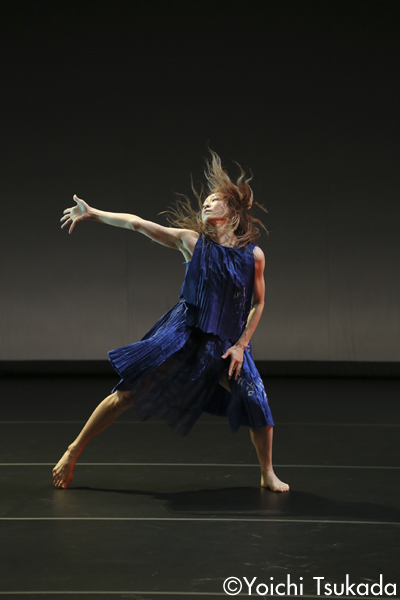
(Mar. 16 – 17, 2013 at Setagaya Public Theatre)
Photo: Yoichi Tsukada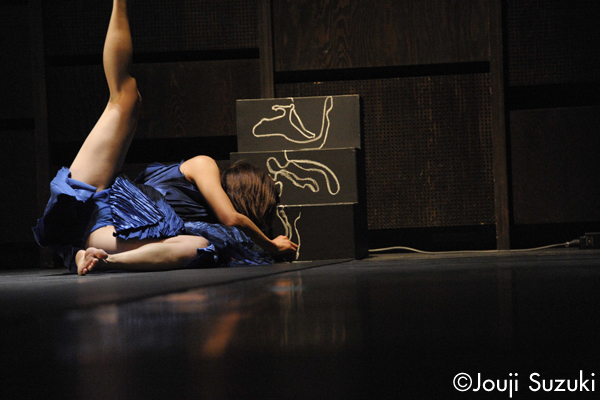
(Nov. 3 – 4, 2012 at Iwaki Performing Arts Center “Alios”) Photo: Jouji Suzuki
Un Yamada’s solo dance
Dictee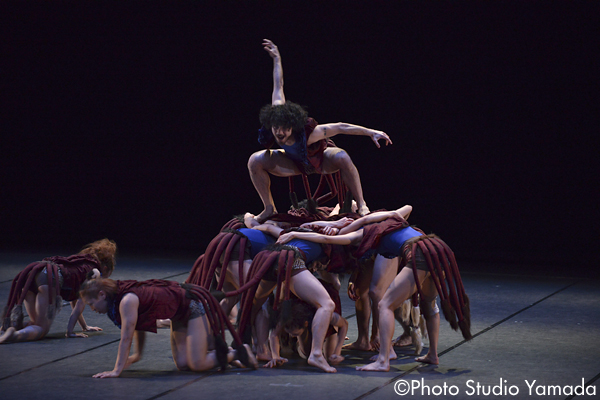
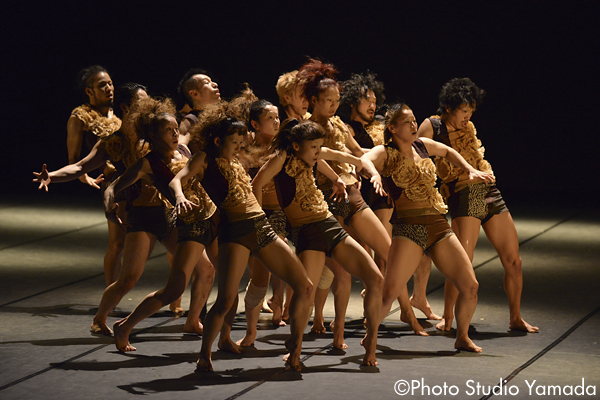
Co. Yamada Un
The Rite of Spring
Photo: Studio Yamada
Photos courtesy of Chigasaki Cultural Foundation.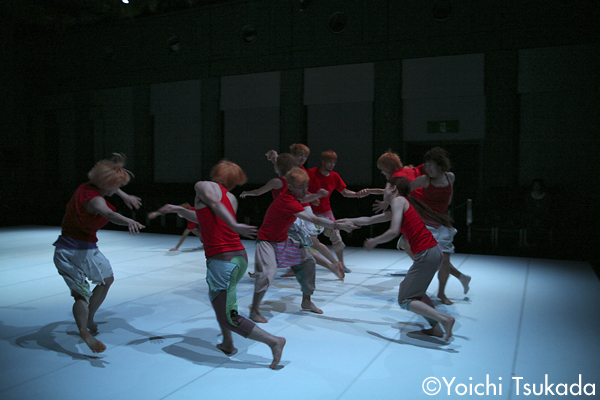
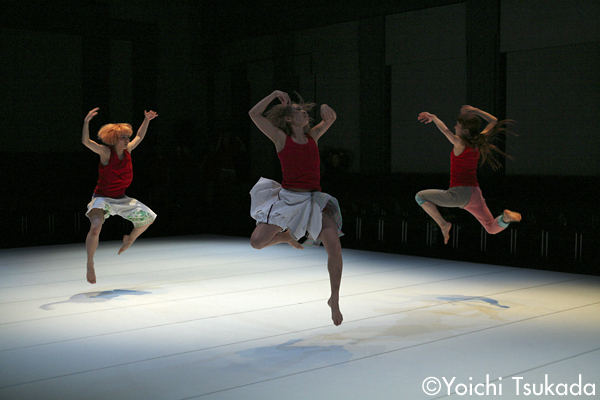
Co. Yamada Un
Shomen
(Mar. 13 – 14, 2010 at Spiral Hall)
Photo: Yoichi Tsukada
Related Tags


